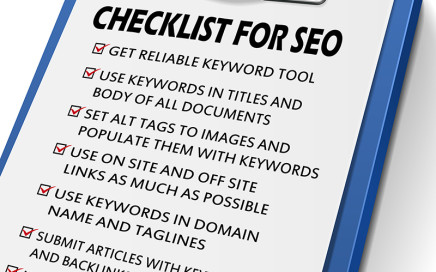Checklist for Search Engine Optimization
Search engine optimization is now a necessary technique in your web development and marketing as increasing numbers of consumers use the internet for research and buying.
The following questions will help you assess the extent of your SEO and where you need to fill in gaps.
Strategy for SEO
Do you have an SEO strategy?
Have you researched popular keyphrases in your industry?
Do you know your competitors strengths in keyword rankings?
Does your SEO research integrate with your content/blogging strategy?
Have you considered SEO in your publicity plan?
Are you optimizing your social media profiles and directory listings?
Do you have a content strategy that takes advantage of new trends, upcoming events and seasonal activities?
Have you set up Google analytics and are using it?
WebSite Built for Search
Is your website mobile friendly?
Do your pages load quickly?
Are you using an SEO plugin?
Are your keywords in your navigation?
Do you have a site map?
Do you have targeted landing pages?
Are you using any other content types? (A content type provides a list of entries that will each link to their own page, like a blog)
Do you have automated urls? (url alias)Do you have a site map?
If you have a store, are the product titles showing up in the url address? Are these titles using clear search words for your products?
Content for SEO
Are your keywords in the body of your text?
Are you using internal linking?
Do you have an FAQ section? Is it set up with different pages for each question?
Do you have separate services pages for each of your services?
Do you have a Blog?
Is there content changing on your site frequently?
Are you currently using an SEO module for blog posts?
Are you using images with your blogs that have tags and captions?
Are you feeding in posts from twitter, facebook or other feeds?
On Page Optimization Checklist (Deep)
Does your blog cover a topic readers will search for?
Did you determine a good key‐phrase to focus on?
Does your key‐phrase have adequate searches and low competition?
Does the following include a relevant key‐phrase: Title, url, meta description, meta keywords.
Does your body copy have an adequate keyword density?
Did you use your key‐phrase in a Heading 1 format?
Did you include your key‐phrase in other special formatting such as bold, italic, bullets?
Did you tag the post with this key‐phrase?
Is the key‐phrase you want to focus on the first one in your keyword meta tags?
Is the key‐phrase used at least once in your meta description?
Do you have multiple images and relevant links? More is better!
Do you have an alternate description and title attributes for the image?
Did you save the image with the key‐phrase in the file name?
Do you have title attributes (or anchor text) for your hyperlink?
Do the outbound links have the key‐phrase in their url address?
Do you have inbound links through your site (with anchor text)?
I call this deep optimization. You do not have to do everything, but the more the better. Keep in mind not to go overboard on the keyword density in your body copy. You still want your blog to read well and you page not to get black-listed as spam. Also you need to find balance between a well‐optimized title and a catchy title that will be enticing to read. Subtitles work well.
Keep in mind your SEO strategy as you add content to your website. Slowly it will become a habit and your search rankings will improve.
Happy blogging!

